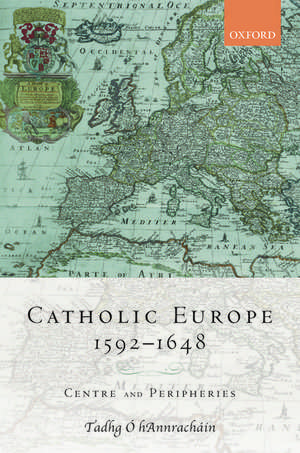Catholic Europe, 1592-1648: Centre and Peripheries
Autor Tadhg Ó hAnnracháinen Limba Engleză Hardback – 14 oct 2015
Preț: 512.04 lei
Preț vechi: 965.34 lei
-47% Nou
Puncte Express: 768
Preț estimativ în valută:
97.98€ • 102.57$ • 81.07£
97.98€ • 102.57$ • 81.07£
Carte tipărită la comandă
Livrare economică 26 martie-01 aprilie
Preluare comenzi: 021 569.72.76
Specificații
ISBN-13: 9780199272723
ISBN-10: 0199272727
Pagini: 282
Dimensiuni: 164 x 236 x 23 mm
Greutate: 0.59 kg
Editura: OUP OXFORD
Colecția OUP Oxford
Locul publicării:Oxford, United Kingdom
ISBN-10: 0199272727
Pagini: 282
Dimensiuni: 164 x 236 x 23 mm
Greutate: 0.59 kg
Editura: OUP OXFORD
Colecția OUP Oxford
Locul publicării:Oxford, United Kingdom
Recenzii
the book represents a pioneering study in comparative earlymodern European Catholicism. It contributes to the understanding of the role of religion and the Catholic elites in earlymodern European kingdoms, and to the importance played by seminary colleges in the education of the Catholic elites.
displays an enviable command of multiple languages and archives, and mastery of an impressive array of specialist literatures ... The story of how the peripheries of sixteenth-century Catholicism -- Ireland, Austria, Poland -- became its nineteenth and twentieth-century heartlands is necessarily a complex one, and this book is an invaluable map to the first stages of that journey.
Ó hAnnracháin's study is innovative in directly illuminating the disparity between plural Catholicism across Europe and an orthodox form of religion that emanated from the "center" in this period ... Ó hAnnracháin's work reveals not only the need to resituate local studies and use comparative methodology, but also to understand the negotiation and encounter between "central" and "peripheral" forms of Catholicism ... One of Ó hAnnracháin's most valuable contributions, however, is to show that the "peripheries" are of critical importance for advancing our understanding of early modern Catholic Europe.
The strength of Ó hAnnracháin's work lies in the breadth of his comparisons between territories on the margins, and he makes a significant contribution to our understanding of the peripheral communities of early modern Catholic Europe, as well as their diverse relationships with the centre.
The book's central aim is the analysis and comparison of the dynamics between the Roman centre and the diverse Catholic communities on its peripheries. It succeeds spectacularly not only in showing the discrepancies between the Tridentine ideal and the situation in these localities but also how contingent on local circumstances the success of the reforming programme was ... provides a meticulous exposition of the extremely variegated dynamics
displays an enviable command of multiple languages and archives, and mastery of an impressive array of specialist literatures ... The story of how the peripheries of sixteenth-century Catholicism -- Ireland, Austria, Poland -- became its nineteenth and twentieth-century heartlands is necessarily a complex one, and this book is an invaluable map to the first stages of that journey.
Ó hAnnracháin's study is innovative in directly illuminating the disparity between plural Catholicism across Europe and an orthodox form of religion that emanated from the "center" in this period ... Ó hAnnracháin's work reveals not only the need to resituate local studies and use comparative methodology, but also to understand the negotiation and encounter between "central" and "peripheral" forms of Catholicism ... One of Ó hAnnracháin's most valuable contributions, however, is to show that the "peripheries" are of critical importance for advancing our understanding of early modern Catholic Europe.
The strength of Ó hAnnracháin's work lies in the breadth of his comparisons between territories on the margins, and he makes a significant contribution to our understanding of the peripheral communities of early modern Catholic Europe, as well as their diverse relationships with the centre.
The book's central aim is the analysis and comparison of the dynamics between the Roman centre and the diverse Catholic communities on its peripheries. It succeeds spectacularly not only in showing the discrepancies between the Tridentine ideal and the situation in these localities but also how contingent on local circumstances the success of the reforming programme was ... provides a meticulous exposition of the extremely variegated dynamics
Notă biografică
Tadhg Ó hAnnracháin is currently Head of School of History at University College Dublin. He completed his PhD at the European University Institute at Florence in 1995. He has published widely in journals such as English Historical Review, History Compass, Shiso, Revue Historique, Proceedings of the Royal Irish Academy and in numerous edited collections. He was the joint Principal Investigator on the Irish Research Council Thematic Grants projectInsular Christianity. His research interests are primarily in the field of Early Modern religious history. Catholic Europe, 1592-1648: Centre and Peripheries is his second monograph with Oxford University Press.













